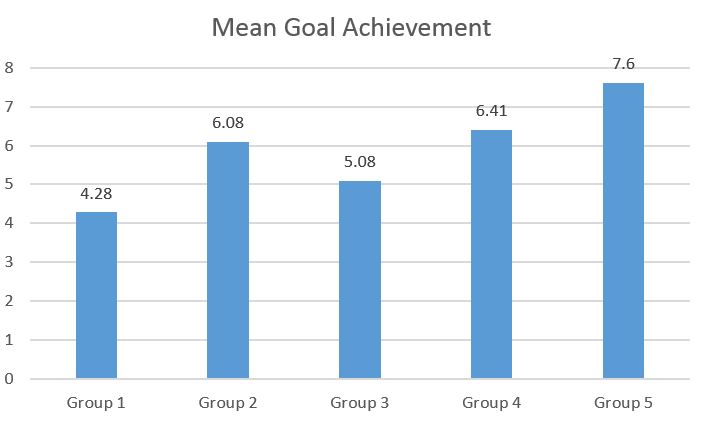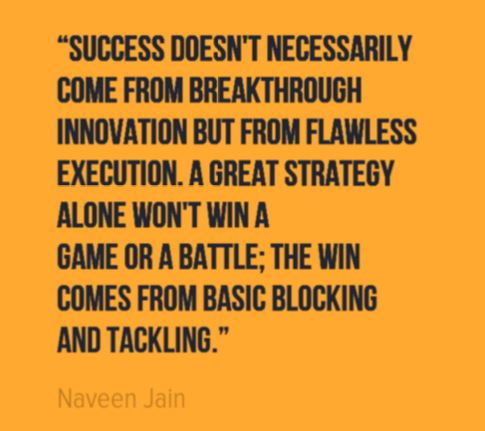“Success doesn’t necessarily come from breakthrough innovation but from flawless execution. A great strategy alone won’t win a game or a battle; the win comes from basic blocking and tackling.” Naveen Jain
I love this quote from entrepreneur Naveen Jain. Mr. Jain makes a great point. The battle or game is WON by the blocking and tackling. The daily hand-to-hand combat of your business. It’s the day to day activities of individual employees that makes all the difference.
If you’ve been a small business consultant for any length of time, you’ve been in a position where a client did not execute a strategy you helped to develop. They were not able to translate the strategy to daily “wins”. This is really frustrating especially since your main objective is your client’s success.
As I write this post, it is officially the last day of Q1’16.
So, how have your clients executed against the plan you helped to create? What progress did they make in Q1’16? What targets where met and what targets were missed? How did you check-in with your client to ensure the daily and weekly “wins” were happening?
The point of this blog post is to give you 4 ways in which you can help your client achieve greater results and to help you to drive higher revenue in your consulting business.
In a study on achieving goals, a team at Dominican University asked a group of participants to perform various tasks to determine which behaviors helped the participants the most.
Here’s what each group did
- Defined goals but did not write them down
- Wrote down their goals
- Wrote down their goals and performed some specific actions
- Wrote down their goals, performed some specific actions and made commitments to a friend
- Wrote down their goals, performed some specific actions, made commitments to a friend and sent a weekly progress reports
 You can see that the group with the highest goal achievement was in Group 5 which produced a weekly progress report. In essence they did a weekly check-in with their accountability partner. There was a built in “keeping score” to determine if that individual was “blocking and tackling” correctly.
You can see that the group with the highest goal achievement was in Group 5 which produced a weekly progress report. In essence they did a weekly check-in with their accountability partner. There was a built in “keeping score” to determine if that individual was “blocking and tackling” correctly.
This is intuitive, but hard to do. We all know that when we report our results to someone else, we are more motivated to achieve them. We don’t want to show up at the meeting not having achieved the goal we committed to achieve.
We’ve all seen this in practice. This is how some weight-loss technology platforms work. For example, with MyFitnessPal and you can share your progress with your friends. You receive encouragement to keep going and get likes when you succeed.
Accountability Is Difficult
We also know that accountability is difficult for many small business owners. They may not admit that they need an accountability partner or a system which drives accountability. An HBR article indicated that 50% of all managers are terrible at holding their direct reports accountable.
According to the article, “No matter how tough a game they may talk about performance, when it comes to holding people’s feet to the fire, leaders step back from the heat.”
Another HBR article stated, “Managers are quick to take credit for good results, but are often reluctant to accept responsibility for failure.” In fact, people generally avoid accountability, making a check-in process even more critical.
So what’s a consultant to do? You help create a plan, expecting your client is going to drive results and hold their staff accountable and in 50% of the cases, they do just the opposite.
How You Can Help
Given the challenges you are up against; how can you adjust your approach in your consulting business? How do you help drive execution and facilitate a culture of accountability? Here are 4 steps….
- Ensure the goals are clear to the entire leadership team (this is level 1-2 on the Dominican University study).
What is your client really trying to achieve? Ensure you have clarity around the specific problem you are helping them solve. Tie each goals to at least one KPI and agree on the frequency of data collection (weekly, monthly, quarterly).
- Ensure each member of the leadership team understands which goal they responsible to achieve (this is level 3-4 on the Dominican study)
This is also a big problem in many small businesses. Everyone is responsible for everything therefore no one is really on the hook for anything. This usually shows up when you attempt to assign accountability for a goal and no one raises their hand to achieve it.
- Agree to check-in at some regular interval (this is level 5 on the Dominican study)
This is where execution really begins to happen. Let your client know that in order to be the most successful (remember the study?), a monthly check-in is necessary to hold the team accountable. Many clients actually appreciate and crave this level of accountability, so give them what they need. Your clients are going a million miles a minute, so having an unbiased person outside their organization is really valuable to them. Be that person.
- Use a platform to make goal tracking easy (we suggest this one)
Lastly, move away from excel spreadsheets and word docs to an online platform that allows you and your client to easily access and update their progress. Don’t let multiple and cumbersome spreadsheets be a barrier to success.
So take an assessment of where your current small business clients are in terms of execution. How would a regularly scheduled check-in help to make them even more successful?
Next Steps –
Help your clients execute faster by signing up to attend a FREE 30 minute demo of our business execution platform.
